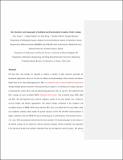| dc.contributor.author | Awaja, Firas | |
| dc.contributor.author | Tripathi, Manoj | |
| dc.contributor.author | Wong, Tsz‐Ting | |
| dc.contributor.author | O'Brien, Timothy | |
| dc.contributor.author | Speranza, Giorgio | |
| dc.date.accessioned | 2019-04-01T12:19:00Z | |
| dc.date.issued | 2018-08-01 | |
| dc.identifier.citation | Awaja, Firas, Tripathi, Manoj, Wong, Tsz-Ting, O'Brien, Timothy, & Speranza, Giorgio. (2018). The chemistry and topography of stabilized and functionalized graphene oxide coatings. Plasma Processes and Polymers, 15(10), 1800084. doi: 10.1002/ppap.201800084 | en_IE |
| dc.identifier.issn | 1612-8869 | |
| dc.identifier.uri | http://hdl.handle.net/10379/15086 | |
| dc.description.abstract | Graphene oxide (GO) thin films and coatings are regarded as superior in quality to other materials especially for biomedical applications. However, the lack of stability and understanding of their structure and defects hinder their use in value added applications. Here, we describe our successful attempt at stabilizing, reducing and functionalizing GO through multiple plasma treatments with polymerizing (to deposit a crosslinking and compressing layer of diamond like carbon, DLC) and non‐polymerizing precursors (H2, O2, and N2). The hybrid GO and DLC coatings on semi crystalline PEEK were evaluated using AFM, SEM, and XPS. The GO deposited layer showed roughness around 70 nm and, despite care, resulted in several wrinkles and particle aggregations. The hybrid coatings conformed to the roughness and crystalline features of PEEK. XPS showed that the DLC layer cross‐linked the GO nano‐flakes while not completely masking which enable the partial exposure of GO. The GO‐DLC hybrid interface is higher in thickness than the PEEK‐GO and is dominating the overall thickness of the hybrid structure ≈13 ± 1 μm. XPS measurements showed that the often unstable CO functional groups on the surface of the hybrid coating can be reduced by effective plasma treatment. Plasma treatments also generated CO functional groups that probably originated from the decomposed carboxyl groups. The plasma treatment also contributed to the reduction of GO. Treatment with H2 was more effective in oxygen reduction than with the N2, however, treatment with N2 increased the reactants on GO as N2 is heavier tending to deposit more on a surface. Plasma treatment with O2 increased the surface oxygen content further and hence more defects on the hybrid surface. | en_IE |
| dc.description.sponsorship | This publication has emanated from research conducted with the financial support of Science Foundation Ireland (SFI) and is co-funded under the European Regional Development Fund under Grant Number 13/RC/2073. This project has received funding from the European Union’s Horizon 2020 research and innovation programme under the Marie Skłodowska-Curie grant agreement No 713690. FA would also acknowledge funding from the FWF under the Lise Meitner program (M-1777). | en_IE |
| dc.format | application/pdf | en_IE |
| dc.language.iso | en | en_IE |
| dc.publisher | Wiley | en_IE |
| dc.relation.ispartof | Plasma Processes And Polymers | en |
| dc.rights | Attribution-NonCommercial-NoDerivs 3.0 Ireland | |
| dc.rights.uri | https://creativecommons.org/licenses/by-nc-nd/3.0/ie/ | |
| dc.subject | Graphene oxide | en_IE |
| dc.subject | thin films | en_IE |
| dc.subject | coatings | en_IE |
| dc.subject | XPS | en_IE |
| dc.subject | molecular structures | en_IE |
| dc.subject | graphene | en_IE |
| dc.title | The chemistry and topography of stabilized and functionalized graphene oxide coatings | en_IE |
| dc.type | Article | en_IE |
| dc.date.updated | 2019-04-01T11:51:44Z | |
| dc.identifier.doi | 10.1002/ppap.201800084 | |
| dc.local.publishedsource | https://doi.org/10.1002/ppap.201800084 | en_IE |
| dc.description.peer-reviewed | peer-reviewed | |
| dc.contributor.funder | Science Foundation Ireland | en_IE |
| dc.contributor.funder | European Regional Development Fund | en_IE |
| dc.contributor.funder | Horizon 2020 | en_IE |
| dc.contributor.funder | FWF | en_IE |
| dc.description.embargo | 2019-08-01 | |
| dc.internal.rssid | 16118704 | |
| dc.local.contact | Firas Awaja, -. - Email: firas.awaja@nuigalway.ie | |
| dc.local.copyrightchecked | Yes | |
| dcterms.project | info:eu-repo/grantAgreement/SFI/SFI Research Centres/13/RC/2073/IE/C�RAM - Centre for Research in Medical Devices/ | en_IE |
| dcterms.project | info:eu-repo/grantAgreement/EC/H2020::MSCA-COFUND-FP/713690/EU/Career Development and Mobility Fellowships in Medical Device Research and Development: A CÚRAM Industry-Academia Training Initiative./MedTrain | en_IE |
| dcterms.project | info:eu-repo/grantAgreement/FWF/Meitner-Programm/M 1777/AT/Osteointegration of Polymer Composites for Medical Implants/ | en_IE |
| nui.item.downloads | 345 | |


